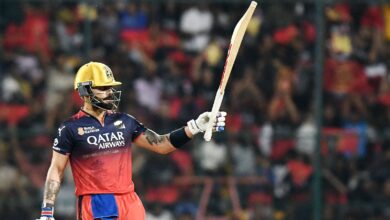How to bat and bowl at the tennis-ball pacy bounce at Perth? Who is India’s matchwinner with the ball and bat?

As crazily tight as the game against Pakan was, India’s first serious test of batting technique would come on Perth pitch against South Africans on October 30. It required a touch of genius from Virat Kohli to make the Pakani pacers bleed (even Hardik Pandya was unable to get going against pacy bounce), but the pitch at MCG is still no match to the bounce we have seen at Perth. South Africa is also loaded with good pacers to exploit the steep tennis ball bounce. Indians did land up in Australia early and chose Perth as their training camp; we shall know soon if that comes in handy now against pace.
It’s been the theme of the tournament so far: Hard lengths from the pacers. Consider this stat: Out of the 389.3 overs bowled in the Super 12 thus far, there have been 157.1 overs of dot balls. 943 balls of either tuk-tuk or beaten or left alone. Sachin Tendulkar had warned against disregarding singles and being thwarted in the ambition of big hits.
“Arre yaar, lagta toh jaata tha (Had it connected, it would have flown), the batsmen would say after getting out, going for big shots. But nahi lagta, tabhi toh you get out; lagta doesn’t matter. Be smarter! There would be some lateral movement. There is a bit of unknown there (playing cricket in Australia in October).” Tendulkar would tell this newspaper about the possible pitfalls for batsmen on the eve of the tournament.
So far, he has been proven right. Lagta doesn’t matter. The Powerplay scores have dipped to 30’s. The dot balls have risen. Bhuvneshwar Kumar has kept the batsmen mute 31 balls, Sikandar Raza 39 times and Mark Wood 27 times.
Even the special coach for big power hitting Julian Wood had told this newspaper about one factor he would keenly track: “There would be loopy tennis ball bounce on fresh drop-in pitches and big boundaries; how would the big hitters adapt is the key,” Wood had said.
So far, not so good; it must be said. Misbah-ul-Haq has been sighing at the television studio in Pakan and doing video tutorials of how to tackle the bounce from a hard length. “Don’t be late with the weight transfer as Asif Ali has been for example. Quick, precise, early movements, and be still when the ball climbs,” to paraphrase Misbah.
Brad Hogg, the former Australian spinner who played his cricket in Perth in Western Australia, too has been surprised at the lack of preparation of some teams. He also reckons the teams bowling in the chase have profited from some more seam movement under lights and learning from the makes of the other team in the first innings.
“I was a little bit surprised. There hasn’t been much swing here at Perth stadium either, especially in the first innings. And that surprises me as well, because the BBL team Perth Scorchers generally get the ball to move around.Also, when you’re bowling second, there just seems to be a little bit more seam movement off a length. But I don’t know whether that’s because the team bowling second has realized that if you go full, it’s going to be easy to get driven. So they do go for that hard length a lot earlier than the first team,” Hogg tells The Indian Express.
Hogg also agreed with Tendulkar on the dot-balls pile-up and put it in context with a match example.
“Take that Zimbabwe versus Pakan game. Zimbabwe bowlers were absolutely sensational. Good hard Test match lengths and kept it tight with pace.”
Drift, drop, and over-spin it
Just not pace, there is a way, Hogg believes, for the spinners to thrive here at Perth, and elsewhere in Australia. Over-spin it, and get the drift and the drop right, he says.
#T20WorldCup
Standing outside the Optus Stadium in Perth, venue for Sunday’s #INDvsSA match, @pdevendra shares his India XI for the contest. pic.twitter.com/iBDNPFZaVV
— Express Sports (@IExpressSports) October 29, 2022
“Again, the Zimbabwe bowlers like Sikandar Raza showed the way: they were up and over, so was Pakan’s Shadab Khan. Others like Mohammad Nawaz weren’t; they were flatter and quicker. When I say up and over, I mean, a bit of flight and over-spin the ball to use the bounce. That bounce, even if you don’t get much turn, can defeat the batsmen’s big hits or make them mime them. There is that fizz in the air when the ball drifts and drops on a good length. You can bowl a bit quicker if you wish but you have to get that drift and drop. Without them, you have taken away the assets that can beat the batsmen in flight.”
Hogg drops another example. “Consider how Marcus Stoinis hit the Sri Lankan spinners. It was a lot easier for him to hit through the line, once he picked up the line and length earlier as there was no drift and drop or bounce.
Not many slower balls, please
The success of hard lengths has led to near-disappearance of the T20 staples: slower ones and yorkers. The yorkers were already fading out of the game with the pacers so wary of the deep-in-the-crease positions that the big hitters take but slower-ball specials were in demand across teams in the T20 leagues. Be it Harshal Patel or Dwayne Bravo. That is changing this world cup.
Wasim Akram and Waqar Younis, the toe-crushers from hell, have been repeatedly stressing about the hard lengths, urging their pacers not to go too full or attempt too many slower balls. When Pakan lost to India, Akram perked up on A Sports. “They bowled nine slower balls in that final phase. And the make Haris Rauf did with the fifth ball of the 19th over (that Kohli walloped over straight boundary for an unearthly six) was he bowled the slower ball (that allowed Kohli to rock back and flat-punch it).”
Unsurprisingly, Hogg agrees with the two W’s. “Definitely. I don’t think you can afford to be full here at Perth Stadium. Someone like Anrich Nortje whom India are going to face on Sunday, I’d expect him to be bowling more balls at high pace. The only time he would go to a slower ball is if the batsman’s footwork is a little bit uncertain, not moving his feet. Then a full slower one makes the batsman just bob it up to the infield catchers,” Hogg says.
Something that the tall Zimbabwean Blessing Muzarbani did. “At one point, he bowled three slower balls in a row and since the Pakanis were lining up for the big hit, it worked. So you have to be smart as a bowler. We saw (Richard) Nagarva was brilliant, hitting that hard length, taking it across the right handers.”
Why has the traditional Test-match length proving so hard for the batsmen. Even for someone like Pandya, who doesn’t rush into his shots like some of the Pakanis did. He has a method: waits in his slightly opened-up stance, and has the shots to cover either length – full or short.
“It’s the tennis-ball bounce,” Misbah would say. And so does Hogg. Simon Helmot, a BBL and IPL coach, had told this newspaper about the difficulties for the batsmen. “The tennis ball bounce is not the sharp, fast rearing-at-face bounce like we used to see at the old Waca pitch at Perth,” Helmot says. These days cricket is played at the new Optus Stadium at Perth with a drop-in pitch.
“The batsmen have to adjust their bat-swings more carefully. As the bounce is loopy, high and has a strange pace to it.” We saw that with Pandya. Time and again, he swung from good positions but couldn’t time his shots. “It can be done if you train properly and have time; it’s a tweak but necessary one,” Helmot had said.
Hogg agrees with that perspective. “Some batsmen have been trying to overhit it. If you get into good positions and just try to time the ball, especially in that Powerplay, you’ll get value for shots. I just think it’s a lack of preparation, but it’s a short turnaround too, of short turnaround of tournaments. Teams have come over and haven’t been able to get much practice. You fly over, you’ve got one game out the way or out per Stadium and then you’re off,” Hogg says.
Tendulkar had added another caveat to it. “You have to hit with the breeze. The wind factor becomes crucial in Australia.”
Hogg, who has played much of his cricket at Western Australia, points out another vital aspect of the batting technique: how high should the bat’s back-lift be at Perth?
“I have observed that the batsmen still come here with a bigger backlift of the bat (in stance). If you’re new to the particular surface, lower your back lift down a bit and focus on timing. So that means that you’ve got to have good footwork, good balance and just hit through the line of the ball. If you do that, I think you’re going to survive a lot more and you’re going to have high strike rates.”
And as ever, a big heart. “The other night I was speaking to Ibrahim Zadran after he faced England’s Mark Wood and he really enjoyed the contest and it was the quickest he’s ever faced and the bounciest he’s ever faced, but he really enjoyed it and he took it on the chin and loved it,” Hogg tells this newspaper.
Hogg has one final advice for the bowlers to bowl at the bouncy Perth pitch: Don’t get too excited and bowl too short.
“Everyone feels Perth is like a red-carpet for pacers. Hard length is not very short one. Some get a little excited that they have to just go and bowl much shorter than what they should be. That’s where I loved Zimbabwe the other night. They hit the same length as they ball on any other surface around the world. That basically doesn’t have to change much from there. There is a double header as well, so there will be more cricket on this particular surface.”
With his natural penchant for back of lengths, Mohammad Shami can be India’s main weapon. “Shami will be the key against South Africa because he hits that seam well,” Hogg says. “If India bowl second, the ball will seam around under lights. Shami can exploit it.”






